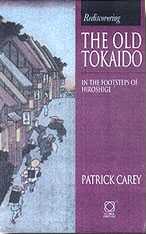|
The Tokaido, Japan's single most important road during the
Edo Period (1600-1868), covered 303 miles between Tokyo and Kyoto. Hiroshige, a
famous Japanese artist who lived from 1797 to 1858, immortalized the Tokaido
with his series of woodblock prints of the "53
Stages of the Tokaido." These color prints richly depict a wide variety of Japanese
scenery, including ordinary people going about their daily occupations.
Although little of the old Tokaido
remains, one brave adventurer set forth from Tokyo to see if he could walk along
the original road. Patrick Carey, who moved to Japan in 1980, traveled
along the entire road as he tried to identify, in the modern landscape, the
sites that Hiroshige had depicted in his woodblock prints. Mr. Carey tells the
story of his exciting trip in the book Rediscovering
the Old Tokaido: In the Footsteps of Hiroshige, which includes full-color
reproductions of all of Hiroshige's original prints of the Tokaido.
In the city of Chiryu (known in
Hiroshige's time as Chirifu), Mr. Carey tried to find the place of Hiroshige's
horse fair print. He was directed to a gentleman at a general store there who
knew all about local history. Mr. Carey not only found out the location of the
horse fair print but also heard the story of the Friendship Dolls exchanged
between America and Japan in 1927. The following story is an excerpt from Mr.
Carey's book on the Old Tokaido.
|
|
|
|

|

|
|
|
|
His grand-daughter came in and set two cups of green tea on the table in
front of us. Sitting there in the middle of this cluttered and friendly shop I
listened as Imazu-san told me about the history of Chirifu and about his own
life. He was eighty-one and had once taught in a primary school. He had
learned English by teaching himself and by corresponding with numerous
pen-friends in the United States.
He went to a back room and returned with a cardboard box labelled in
English 'Letters from America'. He opened it and passed me a sheaf of papers.
The letters were from several states but most were postmarked Niagara Falls,
New York. The earliest was dated 1930.
Imazu-san told me how it had all started. In 1927 an American
philanthropist had the idea of fostering international friendship by getting
young Americans to send dolls to children of other countries. Japan was
targeted first because it had recently suffered a severe earthquake and the
death in 1926 of the Emperor. Also, relations were at a low ebb due to
Japanese immigration and new US laws to restrict it. Thirteen-thousand dolls,
each with its own name, number and Japan-America friendship passport, were
sent to schools all over Japan. (The return trade was somewhat unbalanced:
fifty-eight dolls were sent from Japan to American schools.)
One of these dolls arrived at the school where Imazu-san taught and he
wrote to the American organization asking to be put in touch with the sender.
The result was an international correspondence involving the members of Mrs.
Inez McKellip's Sunday school class in Niagara Falls, NY.
I picked up letter after letter, some typed, some in beautiful handwriting:
letters from a Harry Selby, Harriet M. Dunn, Emily Mary Dunn, Morris Charles
Musgrave.
One letter acknowledged receipt of a Japanese doll but regretted that the
doll's head had arrived broken. Another, dated 1930: 'I hope sometime it will
be possible for you to visit our country. It does not seem so far away as it
did years ago since transportation is so much better and faster.' (This in the
days before the Boeing 747.)
A plaintive note is struck in a letter that says that the writer has
written three times but has had no reply.
'Please write soon.'
Another, dated 21 October 1932:
'I have been saving up newspapers telling about the difficulties between
Japan and China. I shall send them this week.'
This was just a year after the Manchurian Incident, the first in a series
of incidents that were to lead eventually to Japan's outright invasion of
China and confrontation with the United States.
Imazu's correspondence with his friends in Niagara Falls came to an abrupt
end in December 1941. In 1943 the Japanese government ordered the destruction
of the friendship dolls. Of the original thirteen thousand only two hundred
are known to have survived.
In early 2001, Patrick Carey visited Niagara Falls in search of
relatives or friends who know the original people with whom Imazu-san
corresponded so many years ago. An elderly gentlemen who has lived in
Niagara Falls all his life is helping in the search, and Mr. Carey is
writing to all of the Dunns he found in the local telephone directory.
If anyone knows something about Harry Selby, Harriet M. Dunn, Emily Mary Dunn,
or Morris Charles
Musgrave, please contact Patrick Carey at carey@reitaku-u.ac.jp
Return to Friendship Dolls - Letters
|
|
